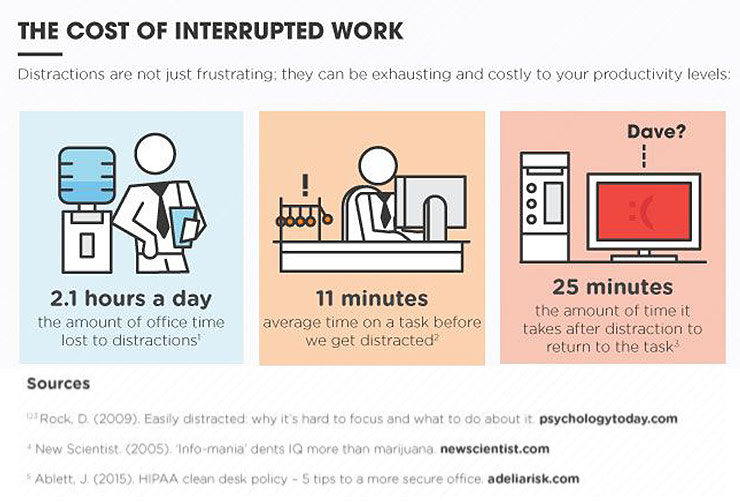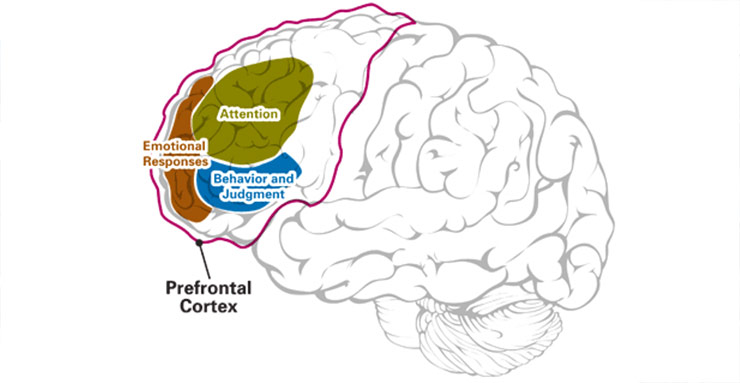Why looking at nature improves our cognitive performance

Our cognitive resources are in greater demand than ever before!
Many of us today are in multi-skilled professions, involving a wide range of tasks that may be very different from one another. What’s more, with such a large number of information channels available in this digital age, our brains have never had to deal with such a constant flow of information. In a work situation, on average, our brain is inundated by 11 million bits of information per second, yet we can only consciously process 120 bits of information per second1. At the same time, we are subjected to distractions throughout the day, repeatedly redirecting our attention. In an office environment, this information overload can result in a loss of productivity of anything from a few minutes to several hours per day, as shown in the illustration below:

The cost of interruptions at work (source: https://www.visualistan.com/2016/06/how-to-focus-at-work-in-the-age-of-distractions.html)
This loss of productivity is costly for businesses, with almost USD 588 billion lost per year in the United States for example2(remember, salary costs make up almost 90% of the cost of running a business). And according to some studies3, workers compensate for these interruptions by working faster but this comes at a cost, leading to increased stress, frustration, pressure and effort. The risk of errors also increases.
Limited resources subject to fatigue
Moving from one task to another quickly, maintaining concentration and staying focused on one task for several hours, and differentiating between important and interesting information takes significant effort from a cognitive point of view4.

Our cognitive abilities have limits and can suffer fatigue
This kind of fatigue is not surprising if we consider that the brain, as a muscle, consumes more than 20% of our energy intake per day5, which is more than any other organ of the body. Our cognitive resources are certainly not unlimited and are gradually exhausted over time. Our attention span and concentration are at their peak at the start of the day. These abilities decrease throughout the day, increasing the risk of loss of concentration and errors.
A new perspective on attention
Attention as it is generally understood is connected to a set of processes that enable us to perform a range of cognitive tasks such as planning, analyzing, remembering, solving problems, selecting and organizing information. But although the meaning of this word may seem obvious at first, there are actually several types of attention.
In their attention restoration theory (ART), Rachel and Stephen Kaplan, researchers in environmental psychology, distinguish between two forms of attention6:
- Directed attention (also called ‘sustained’ or ‘voluntary’ attention)
- Involuntary attention (also called ‘spontaneous’ or ‘non-directed’ attention)
Directed attention is a key mental resource that allows us to remain focused on a task requiring significant effort for a long period, inhibiting any external or internal stimuli (i.e. our thoughts). It is connected to ‘high-level’ regions located in the prefrontal cortex, often described as the executive center of the brain7.

The prefrontal cortex controls executive functions such as attention, regulation of behavior and our emotional responses
(source: https://www.mybraintest.org/brain-function-areas-structure-map)
Involuntary attention is passive attention, which is effortless, automatic and induced by something intrinsically interesting or exciting.
According to ART, directed attention is a limited resource, subject to fatigue after significant and extended use8. The consequences of attentional fatigue include becoming more easily distracted, limited capacity to see the big picture and make decisions, increased risk of making errors, impulsive behavior and irritability, more hostile behavior, reduced self-control, and reduced control of negative emotions and stress9. So imagine the consequences for a company if its employees, or even its leaders, try to persevere with their work despite suffering from mental fatigue – they are guaranteed to burn out.
The factors of a ‘restorative’ experience
Fortunately, there is a solution available to restore our directed attention: visual contact with nature. Instead of demanding our directed attention, looking at scenes and landscapes of nature captures our involuntary attention, allowing our directed attention to ‘rest’ and thus ‘restoring’ our attentional capacity.

Looking at nature requires no cognitive effort and restores our attentional capacity
In general, the natural environments we are exposed to each day, such as forests, parks, gardens, rivers, green areas, etc. – even in an urban context – are enough to provide these beneficial effects10, 11. And we only need a short period of exposure, i.e. a few seconds to a few minutes,12,13 to feel the effects. Look at a tree outside the window, look at its branches covered with snow, the changing colors of its leaves, the birds among its branches – these are all ‘restorative micro-experiences’ that can restore our attentional capacity.
ART is one of the most documented theories to date explaining the restorative benefits of contact with nature in human beings. It is based on numerous empirical studies14 conducted on subjects who performed cognitive tests after having been exposed to natural environments, either via views through the window, through direct immersion in natural environments, or by viewing photos or videos15.

Looking at nature for a moment helps to restore our cognitive resources
Creating ‘restorative’ environments
Designing interior spaces, such as office environments, that are conducive to restoring attentional resources is crucial to an organization's bottom line. Offices with large windows, for example, offer employees opportunities for micro-restoration, improving their well-being, performance, and motivation 16, 17. Plus providing sources of natural light improves well-being and health.

Wide views of nature create restorative micro experiences from indoors
In schools, directed attention is also the resource that is most important in maintaining concentration and learning, and a lack of concentration is often responsible for academic failure. It is therefore important to ensure that classrooms, corridors and reception and dining areas have views over green spaces18.
In care facilities, providing access to views of nature can also be beneficial for older people with reduced attentional capacity, and for patients suffering from cognitive disorders after a major operation, for example19.
Considering that 70% of the world's population will live in cities by 2050, these solutions will need to be combined with strategies for integrating nature in future urban planning and design. The biophilic movement, based on recognizing the human need for contact with nature and its various benefits, has contributed over recent years to an increase in the creation of green spaces in the cities of the world. Planting trees, creating parks, and placing greenery on rooftops, walls, and facades – are just some of the strategies employed by a growing number of communities, architects, businesses, and citizens to improve well-being while also responding to the environmental challenges of this century.
- The Organized Mind : Thinking Straight in the Age of Information Overload, Daniel J. Levitin
- Spira, J. B., & Feintuch, J. B., The cost of not paying attention: How interruptions impact knowledge worker productivity. New York, NY: Basex, Inc. 2005Gloria Mark, Daniela Gudith, Ultich Klocke,
- The cost of Interrupted work : more speed and stress
- www.theguardian.com/science/2015/jan/18/modern-world-bad-for-brain-daniel-j-levitin-organized-mind-information-overload
- D.D Clarke, L Sokoloff, Circulation and energy metabolism of the brain, Basic Neurochemistry: Molecular, Cellular and Medical Aspects, Lippincott-Raven, Philadelphia (1999), pp. 637-669
- Kaplan, R. & Kaplan, S., The Experience of Nature: A psychological perspective. New York: Cambridge University Press, 1989
- Amy F.T. Arnsten, The Neurobiological Basis of Attention-Deficit/Hyperactivity Disorder, Primary Psychiatry, 2009
- Kaplan, S.,The Restorative benefits of nature: Toward an integrative framework, Journal of environmental psychology (1995) 15, 169-182
- Rita Berto,The Role of Nature in Coping with Psycho-Physiological Stress: A Literature Review on Restorativeness, Behav. Sci. 2014 , 4, 82 -409
- 1R. Kaplan, S. Kaplan, R.L. Ryan, With People in Mind: Design and Management of Everyday Nature, Island Press, Washington, DC (1998)
- Dmitri Karmanov, Ronald Hamel, Assessing the restorative potential of contemporary urban environment(s): Beyond the nature versus urban dichotomy, Landscape and Urban Planning 86 (2008) 115–125
- Kaplan R., The role of nature in the context of the workplace, Landscape and Urban Planning, 26 (1993) 193-201
- Lee K.E. et al, 40-second green roof views sustain attention: The role of micro-breaks in attention restoration, Journal of Environmental Psychology 42, 2015
- Kaplan S., Berman M.G.,Directed Attention as a Common Resource for Executive Functioning and Self-Regulation, 2017
- Gregory N. Bratman,J. Paul Hamilton, and Gretchen C. Daily, The impacts of nature experience on human cognitive function and mental health, Ann. N.Y. Acad. Sci. ISSN 0077-8923
- Kate E.Lee, Leisa D.Sargent, Nicholas S.G.Williams, Kathryn J.H.Williams, Linking green micro-breaks with mood and performance: Mediating roles of coherence and effort, Journal of Environmental Psychology, 2018
- R. Kaplan,The Nature of the View from Home: Psychological Benefits, Environment and Behavior 2001; 33; 507
- Dongying Li, William C. Sullivan, Impact of views to school landscapes on recovery from stress and mental fatigue, Landscape and Urban Planning 148 (2016) 149–158
- B Cimprich, Development of an intervention to restore attention in cancer patients, Cancer Nursing, 16 (1993), pp. 83-92